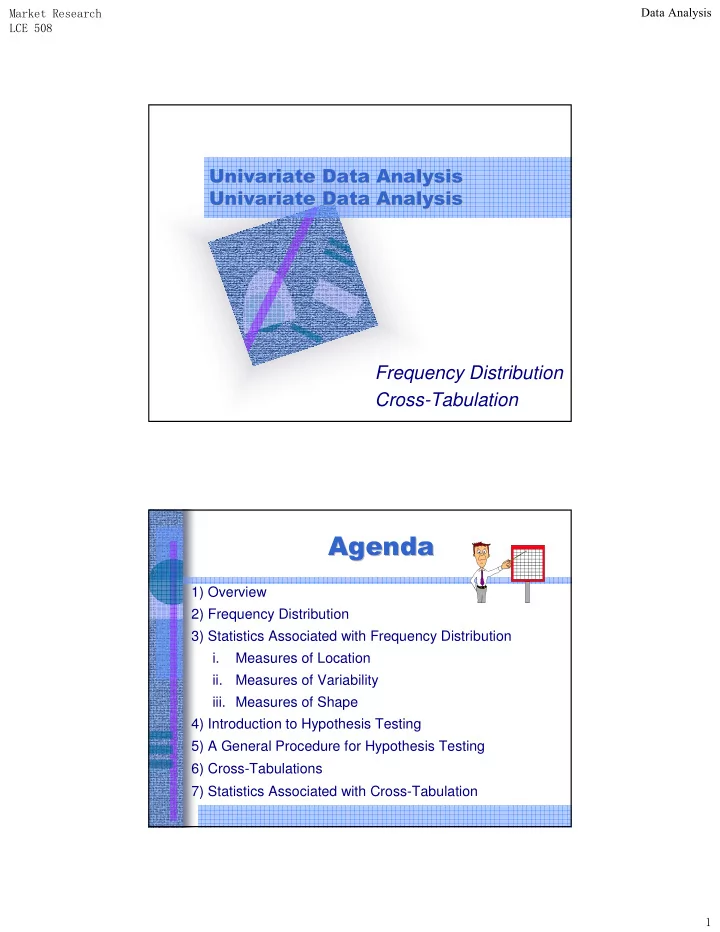

������������� ��������������� ������� ���������� ������������� ������������� ���������� ���������� ������������� ������������� ���������� Frequency Distribution Cross-Tabulation ������ ������ 1) Overview 2) Frequency Distribution 3) Statistics Associated with Frequency Distribution i. Measures of Location ii. Measures of Variability iii. Measures of Shape 4) Introduction to Hypothesis Testing 5) A General Procedure for Hypothesis Testing 6) Cross-Tabulations 7) Statistics Associated with Cross-Tabulation �
������������� ��������������� ������� �������������������� �������������������� ��������������� ��������������� Respondent Sex Familiarity Internet Attitude Toward Usage of Internet Number Usage Internet Technology Shopping Banking 1 1.00 7.00 14.00 7.00 6.00 1.00 1.00 2 2.00 2.00 2.00 3.00 3.00 2.00 2.00 3 2.00 3.00 3.00 4.00 3.00 1.00 2.00 4 2.00 3.00 3.00 7.00 5.00 1.00 2.00 5 1.00 7.00 13.00 7.00 7.00 1.00 1.00 6 2.00 4.00 6.00 5.00 4.00 1.00 2.00 7 2.00 2.00 2.00 4.00 5.00 2.00 2.00 8 2.00 3.00 6.00 5.00 4.00 2.00 2.00 9 2.00 3.00 6.00 6.00 4.00 1.00 2.00 10 1.00 9.00 15.00 7.00 6.00 1.00 2.00 11 2.00 4.00 3.00 4.00 3.00 2.00 2.00 12 2.00 5.00 4.00 6.00 4.00 2.00 2.00 13 1.00 6.00 9.00 6.00 5.00 2.00 1.00 14 1.00 6.00 8.00 3.00 2.00 2.00 2.00 15 1.00 6.00 5.00 5.00 4.00 1.00 2.00 16 2.00 4.00 3.00 4.00 3.00 2.00 2.00 17 1.00 6.00 9.00 5.00 3.00 1.00 1.00 18 1.00 4.00 4.00 5.00 4.00 1.00 2.00 19 1.00 7.00 14.00 6.00 6.00 1.00 1.00 20 2.00 6.00 6.00 6.00 4.00 2.00 2.00 21 1.00 6.00 9.00 4.00 2.00 2.00 2.00 22 1.00 5.00 5.00 5.00 4.00 2.00 1.00 23 2.00 3.00 2.00 4.00 2.00 2.00 2.00 24 1.00 7.00 15.00 6.00 6.00 1.00 1.00 25 2.00 6.00 6.00 5.00 3.00 1.00 2.00 26 1.00 6.00 13.00 6.00 6.00 1.00 1.00 27 2.00 5.00 4.00 5.00 5.00 1.00 1.00 28 2.00 4.00 2.00 3.00 2.00 2.00 2.00 29 1.00 4.00 4.00 5.00 3.00 1.00 2.00 30 1.00 3.00 3.00 7.00 5.00 1.00 2.00 ���������� ������������� ������������� ���������� Examining Summary Statistics for Individual Variables �
������������� ��������������� ������� �������������������� �������������������� • Different summary measures are appropriate for different types of data, depending on the level of measurement: – Nominal (categorical data where there is no inherent order to the categories) – Ordinal (categorical data where there is a meaningful order of categories, but there isn't a measurable distance between categories) – Scale (data measured on an interval or ratio scale) ���������������� ���������������� • For categorical data – From the menus choose: • Analyse – Descriptive Statistics • Frequencies • For Scale Variables – Analyise • Descriptive Statistics – Explore �
������������� ��������������� ������� ���������������������� ���������������������� • In a frequency distribution , one variable is considered at a time. • A frequency distribution for a variable produces a table of frequency counts, percentages, and cumulative percentages for all the values associated with that variable. �
������������� ��������������� ������� ������������������������������������� ������������������������������������� ��� �� ���������� ��� �� ���������� � � � � � � � � � � ��������� ����������� ������������ ������������������������� �� � ������������������������� ����������� � ��������������� � � �� ������ ������������������������������������������������� � � � �� � �� � ����� �������� �������� � � �� � �� � �������� ������� ������� � � �� � �� � ������ ������� ������� � � �� � �� � ������ ������� ������� � � �� � �� � ������ ������� ������� ������������� � � �� � �� �������� ������� ������ ������� � � �� � �� ��������� � � ������ ����� ������� ������ � � ����������!�������� ����������!�������� � � � ��������� � � � � � � � � � � � � ����������� �
������������� ��������������� ������� Statistics Familiarity N Valid 29 Missing 1 Median 5,00 Mode 6 Percentiles 25 3,00 50 5,00 75 6,00 Familiarity Cumulative Frequency Percent Valid Percent Percent Valid 2 2 6,7 6,9 6,9 3 6 20,0 20,7 27,6 4 6 20,0 20,7 48,3 5 3 10,0 10,3 58,6 6 8 26,7 27,6 86,2 Very Familiar 4 13,3 13,8 100,0 Total 29 96,7 100,0 Missing 9 1 3,3 Total 30 100,0 Internet Usage Group Cumulative Frequency Percent Valid Percent Percent Valid Light Users 15 50,0 50,0 50,0 Heavy Users 15 50,0 50,0 100,0 Total 30 100,0 100,0 Internet Usage Group Light Users Heavy Users �
������������� ��������������� ������� ������������������������������������� ������������������������������������� ������������ ������������ �������������������� �������������������� • The mean , or average value, is the most commonly used measure of central tendency. • The mode is the value that occurs most frequently. It represents the highest peak of the distribution. The mode is a good measure of location when the variable is inherently categorical or has otherwise been grouped into categories. ������������������������������������� ������������������������������������� ������������ ������������ �������������������� �������������������� • The median of a sample is the middle value when the data are arranged in ascending or descending order. • If the number of data points is even, the median is usually estimated as the midpoint between the two middle values – by adding the two middle values and dividing their sum by 2. • The median is the 50th percentile. �
Recommend
More recommend